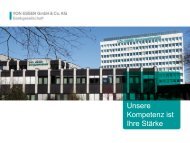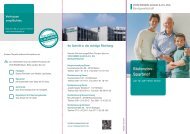2012 Registration document and annual financial report - BNP Paribas
2012 Registration document and annual financial report - BNP Paribas
2012 Registration document and annual financial report - BNP Paribas
- No tags were found...
Create successful ePaper yourself
Turn your PDF publications into a flip-book with our unique Google optimized e-Paper software.
5RISKSAND CAPITAL ADEQUACYCredit risk5Various quantitative <strong>and</strong> other methods are used to check ratingconsistency <strong>and</strong> the rating system’s robustness. Loans to privatecustomers <strong>and</strong> very small businesses are rated using statistical analysesof groups of risks with the same characteristics. GRM has overallresponsibility for the quality of the entire system. This responsibility isfulfilled by either defining the system directly, validating it or verifyingits performance. The teams responsible for verifying performance arenot the same as those who build the models. At <strong>BNP</strong> <strong>Paribas</strong>, a specialSteering Centre has been set up for this purpose.Loss Given Default is determined either using statistical models for bookswith the highest degree of granularity or using expert judgment basedon indicative values, in line with a process similar to the one used todetermine the counterparty rating for corporate books (1) . Loss GivenDefault is defined as the loss that the Bank would suffer in the event ofthe counterparty’s default in times of economic slowdown, as requiredby regulations.For each transaction, it is measured using the recovery rate for a seniorunsecured exposure to the counterparty concerned, adjusted for anyeffects related to the transaction structure (e.g. subordination) <strong>and</strong> for theeffects of any risk mitigation techniques (collateral <strong>and</strong> other security).Amounts recoverable against collateral <strong>and</strong> other security are estimatedeach year on a conservative basis <strong>and</strong> hair cuts are applied for realisingsecurity in a stressed environment.Various Credit Conversion Factors have been modelled by the Bank wherepermitted (i.e. excluding high-risk transactions where the conversionfactor is 100% <strong>and</strong> provided there was a detailed enough track record tobe statistically exploitable), either using historical internal default dataor other techniques when there is insufficient historical data. Conversionfactors are used to measure the off-balance sheet exposure at risk in theevent of borrower default. Unlike rating <strong>and</strong> recovery rate, this parameteris assigned automatically depending on the transaction type <strong>and</strong> is notdetermined by the Credit Committee.Each of the three credit risk parameters are backtested <strong>and</strong> probabilityof default benchmarked <strong>annual</strong>ly to check the system’s performance foreach of the Bank’s business segments. Backtesting consists of comparingestimated <strong>and</strong> actual results for each parameter. Benchmarking consistsof comparing the parameters estimated internally with those of externalorganisations.For the Corporate IRBA scope, all ratings, including default ratings 11 <strong>and</strong>12, for all counterparties to which the Bank has a credit risk exposure,have been recorded in a database since 2002. Likewise, Global RecoveryRates on defaulting exposures at a given time during the period arealso archived. Backtesting is performed on the basis of this informationfor each of the risk inputs, both globally <strong>and</strong> across the scope of eachrating method. These exercises aim to measure overall performance <strong>and</strong>the performance of each rating method, <strong>and</strong> in particular, to verify themodel’s discriminatory power (i.e. the less well rated counterpartiesought to default more often than the better rated ones) as well as thepredictive, conservative nature of the inputs. For this purpose, actualGlobal Recovery Rates (GRR) <strong>and</strong> default rates are compared withestimated Global Recovery Rates <strong>and</strong> default rates for each rating.The “through the cycle” or “downturn” nature of the ratings <strong>and</strong> GRRsrespectively are also verified.This backtesting work revealed that actual default rates on IRBAcorporate scope are significantly lower than estimated default ratesacross the entire cycle (average <strong>annual</strong> default rate of 1.03% between2001 <strong>and</strong> 2011 compared with an estimated rate of 1.82%). An analysisof default rates during crisis periods shows that <strong>annual</strong> default ratesare always lower than estimated rates.Performance measurements are also carried out on sub-scopesof homogeneous asset classes. If the predictive power of a modeldeteriorates, it is recalibrated or redeveloped as appropriate. Thesechanges are submitted to the regulator for approval in line with theregulations.For benchmarking work on non- retail exposures, internal ratings arecompared with the external ratings of several agencies based on themapping between internal <strong>and</strong> external rating scales. Some 10% to15% of the Group’s corporate clients have an external rating <strong>and</strong> thebenchmarking studies reveal a conservative approach to internal ratings.Backtesting of Global Recovery Rates is based mainly on analysingrecovery flows on exposures in default. When an exposure has beenwritten off, each amount recovered is discounted back to the defaultdate <strong>and</strong> calculated as a percentage of the exposure. When an exposurehas not yet been written off, the amount of provisions taken is usedas a proxy for future recoveries. The recovery rate determined in thisway is then compared with the initially forecasted rate one year beforedefault occurred. As with ratings, recovery rates are analysed on anoverall basis <strong>and</strong> by rating policy <strong>and</strong> geographical area. Variances onan item by item <strong>and</strong> average basis are analysed taking into account thebimodal distribution of recovery rates. The results of these tests showthat the Group’s estimates are relevant in economic downturns <strong>and</strong> areconservative on an average basis. Benchmarking of recovery rates isbased on data pooling initiatives in which the Group takes part.The result of all backtesting <strong>and</strong> benchmarking work is presented<strong>annual</strong>ly to the Chief Risk Officer <strong>and</strong> the Bank’s governing bodies. Theseresults <strong>and</strong> ensuing discussions are used to help set priorities in terms ofdeveloping methodology <strong>and</strong> deploying tools. Backtesting is also certifiedinternally by an independent team <strong>and</strong> the results sent to the ACP.Internal estimates of risk parameters are used in the Bank’s day-todaymanagement in line with regulation recommendations. Thus apartfrom calculating capital requirements, they are used for example whensetting delegated limits, granting new loans or reviewing existing loansto measure profitability, determine collective impairment <strong>and</strong> for internal<strong>and</strong> external <strong>report</strong>ing purposes.(1) Within the Group, the Corporate book includes institutions, corporates, specialised financing <strong>and</strong> sovereign states.250<strong>2012</strong> <strong>Registration</strong> <strong>document</strong> <strong>and</strong> <strong>annual</strong> <strong>financial</strong> <strong>report</strong> - <strong>BNP</strong> PARIBAS





